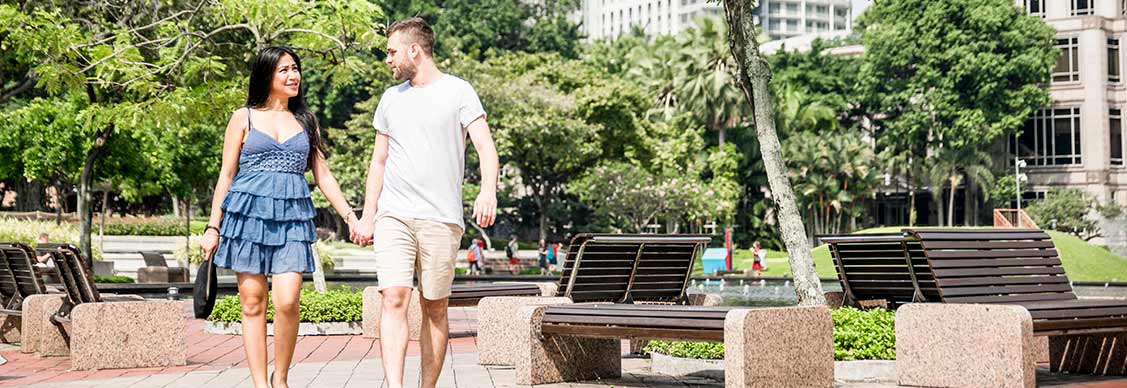Why cities are breaking up big blocks
Mixed-use masterplans aim to build business and communities
It’s a time of reckoning for cities looking to keep central business districts relevant.
Bustling commercial centers built on decades-old habits have undergone massive change in recent years. Evolving business needs and the way people think about health, wellness and their work-life balance are upending some of the time-tested draws of the CBD.
One way cities are responding: breaking up blocks of concrete offices to create pleasant mixed-use districts that foster people-centric, connected communities. From Britain to Australia, Singapore to New York, cities are finding ways to improve and diversify the fabric of their neighborhoods.
Take One Bangkok in Thailand. The sprawling district in the country’s capital city aims to include new offices, a retail quarter, luxury homes and hotels, an entertainment arena, and plenty of open green spaces all within easy reach of the public transportation system.
“It’s been designed as the ultimate urban focal point, with an emphasis on wellness, sustainability, and smart technology,” says Phil Ryan, Director of City Futures, Global Insight at JLL. “This is the kind of integrated business and residential district that we’re seeing start to crop up in cities around the world.”
It’s a counter to the ageing infrastructure, obsolete office stock and peoples’ desire for shorter commutes that are adding to challenges for traditional CBDs, according to JLL’s Future of the Central Business District Report.
“CBDs need to transform from primarily places of work towards being vibrant amenity rich, multi-purpose destinations with a greater focus on ESG,” says Ryan.
Creating liveable places
Breaking up blocks by adding in public squares, pedestrian alleys, cycle paths and biodiversity corridors creates better access within previously dense sections of the city, while less traffic helps improve air quality.
In the U.K., the £500 million ($634 million) Birmingham Smithfield redevelopment will create public spaces and commercial developments, plus 2,000 new homes, all linked by new green streets that give priority to pedestrians and cyclists. To do this, it will have to progressively implement a new street grid over what was once the site of a large wholesale market with no connections from one side to another. This will also enable the site to be developed in four phases, providing additional financial and logistical flexibility.
“Promoting active commutes improves wellbeing, while local businesses benefit from increased footfall,” says Walid Goudiard, JLL’s Head of Project and Development Services for EMEA Work Dynamics. “Having greener, more attractive outdoor spaces also creates opportunities for enhanced street level interaction, such as open-air dining.”
West Side Place in Melbourne has used this strategy to great effect, demolishing a brutalist former newspaper headquarters spanning an entire city block. The new precinct features four towers home to two landmark hotels, a business center and almost 3,000 apartments. Recreation and leisure spaces include parkland and gardens, all connected by new central shopping “laneway.”
Building connections
For cash-constrained local governments, improving transit connectivity is key, but can mean exploring a raft of financing options.
For instance, the successful redevelopment of the former Battersea Power Station in London “was dependent on the infrastructure, so a public/private tax increment model was used to fund the Tube extension and new station,” says Ryan.
The public sector borrowed against the value that came from developing the land, with repayment financed over a period of 25 years by the private sector, using additional “enterprise zone” business rates and contributions secured from developers.
Elsewhere, the constraints of the specific site, local governance regulations and lack of a big picture overview can all hamper progress.
“Communication plus careful financial and physical planning are vital to avoid missed opportunity,” says Ryan. “The people in charge of building transport infrastructure must be aligned with their real estate colleagues.”
Unlocking potential through partnerships
Until now, the focus for many stakeholders has been on the quickest way to maximise return on financial investment.
But Goudiard says that’s starting to change as partnerships are redefined across the real estate industry.
“In the past, things were very transactional,” he says. “Now we’re starting to see a reshaping of the relationships as local authorities, investors, developers and occupiers work more closely together.”
In part, this is down to aspirational local authorities making conditions such as affordable housing and renewable energy sources part of their permits.
Goudiard points to Paris as an example of one such masterplan currently in development. It aims to achieve net zero carbon emissions by 2050, while improving socioeconomic conditions for city residents with better housing, energy and transport infrastructure.
Stakeholder pressure means investors are also starting to consider environmental and social value factors as they seek to make an impact with responsible real estate.
“It’s worth considering the longer-term potential scenarios for growth over a 10-to-20-year time horizon, as these phased schemes present opportunities for acquisition, development, repositioning, conversion, retrofitting and targeted capital improvements,” says Ryan.
It won’t happen overnight, but Goudiard is hopeful about this evolving CBD model that seeks to cater for changing resident and occupier demands.
“In future, ambitious, truly mixed-use city schemes with diverse blocks, greener spaces and improved mobility, will generate premium returns, thanks to their sustainable appeal and value,” he says.
